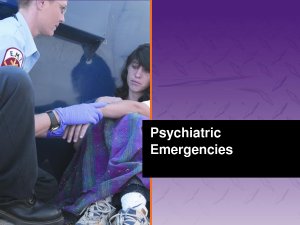Overactive patients are classified as belonging to psychiatric emergencies which are considered a serious disturbance of behavior, thought and personal affect that makes susceptible individuals unable to effectively cope with life situations and interpersonal relationships.
Overactive patients are an important concern of the ED personnel and is further determined whether the individual is at risk of injuring himself/herself as well as others around him. The aim is geared towards maintaining the patient’s self-esteem and life should it be necessary while providing care. Determining whether the patient is presently undergoing psychiatric care is essential so that communication and between the present psychiatric evaluator and the ED personnel caring for the individual can be established.
Who are overactive patients?
Individuals who display uncooperative, non-conforming, disturbed, paranoid behavior and those who feel anxious and panicky are the ones prone to assaultive and destructive impulses and abnormal social behavior, Intense nervousness, depression and excessive crying are remarkable indications in a majority of patients with overactive tendencies. Moreover, disturbed and noisy behavior may be exacerbated or aggravated by alcohol intoxication and drug abuse.
A reliable source in obtaining an accurate history is very important in order to identify the events that lead to the crisis. Past mental illnesses, previous hospitalizations, injuries, abuse of alcohol and drugs, unsolved interpersonal crisis are further probed for a more accurate foundation of the patient’s psyche. Since abnormal thoughts and behavior may be manifested of an underlying physical disorder such as hypoglycemia, stroke, seizure, drug and alcohol toxicity, therefore a thorough physical assessment must also be performed simultaneously while psychiatric evaluation is done.
Approaching overactive patients
The immediate goal for the care of overactive patients is to gain control of the situation. If the individual is very violent towards the ED personnel, security or local police should be nearby the vicinity of the medical facility and emergency department. The use of physical restraints should only be used as a last resort and prescribed when necessary. When approaching the individual, it should be done in a calm, firm and confident manner which is actually a therapeutic way of doing so. Helpful interventions include the following:
- Introduce yourself by name.
- Tell the patient that you are here to help him/her.
- Repeat the patient’s name from time to time.
- Always speak to the patient in one-thought sentences at a time to prevent confusion.
- Allow the patient space and time to talk.
- Show interest in listening and encourage the patient to talk about personal feelings and thought.
- Offer suitable and honest explanations.
Pharmacological adjunct to overactive patients
A psychotropic agent is a drug that exerts an effect on the mind, may be 
After the administration of haloperidol or chlorpromazine against psychotic symptoms of though fragmentation which results in overreaction in behavior, the patient is observed closely to determine the degree of change of psychotic behavior. A subsequent dose will depend on the patient’s response. Typically after administration of psychotropic medications, overactive patients are transferred to an inpatient/outpatient psychiatric unit for further continuing treatment and management.
